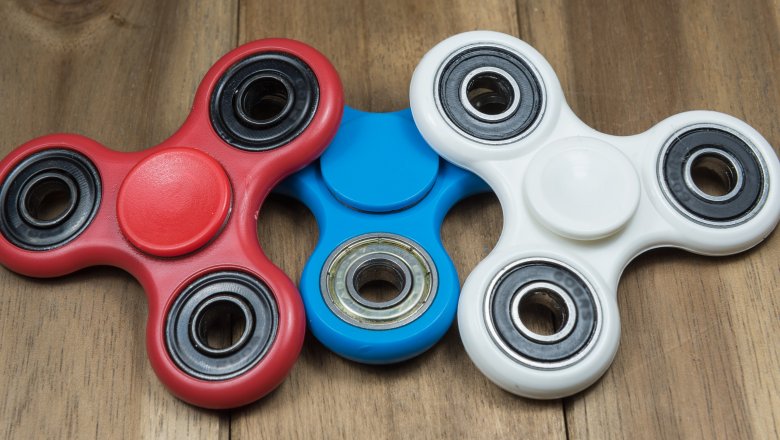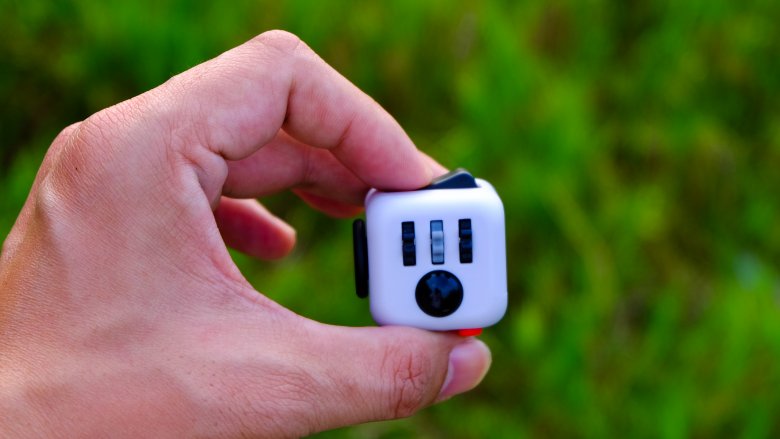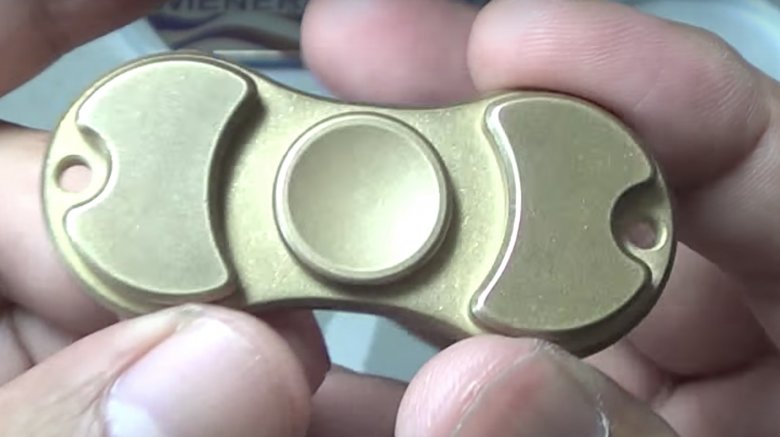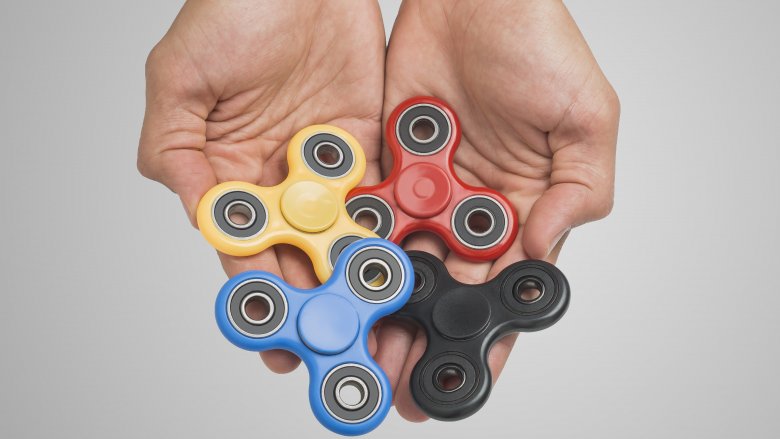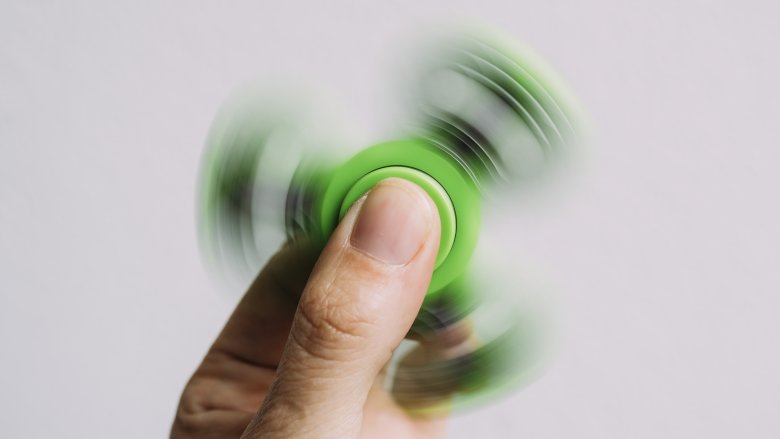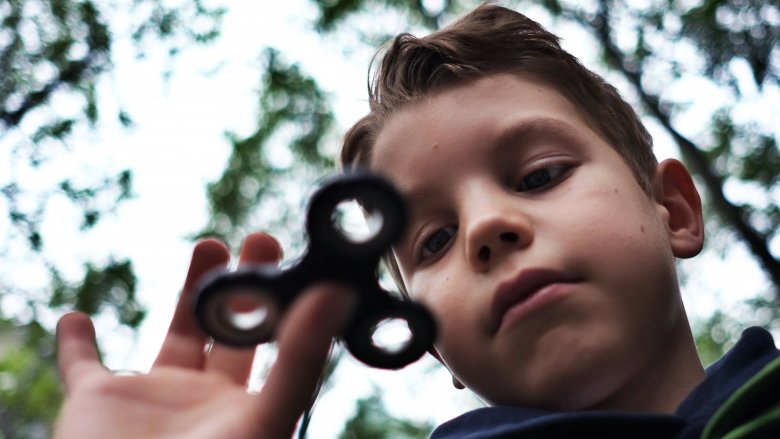The Truth About Fidget Spinners
Not too long ago, fidget spinners were an obscure, productivity-increasing tool. Before too long, however, they'd joined the ranks of slap bracelets, Pogs, Furbies, and Silly Bandz in the pantheon of toy fads. Simple and usually inexpensive, a fidget spinner is a handheld device that spins around when pushed with a finger...and that's about it. Kids love them, and so do adults, claiming that they burn off nervous energy and increase a person's ability to focus. But is that true? Or just a bunch of spin?
Here's the origin story of the fidget spinner...along with how they work and just why they're so popular.
The inspiration started spinning in an inventor's head in the 1980s
Florida resident Catherine Hettinger claims she invented the fidget spinner. While the spinning toy she created and attempted to market is pretty different from the fidget spinners popular today, Hettinger is more of a pioneer in "fidget spinner theory," or the notion that there ought to be a toy to help children relieve nervous energy and increase focus.
Hettinger told Money that she saw some angry kids throwing rocks at police officers in Israel back in the 1980s. She thought that was all quite horrible, and it made her want to create some kind of toy to distract and calm kids. Hettinger explained her first idea toward this end: a soft rock that when thrown didn't hurt anybody. Alas, Nerf balls had already been invented.
The first "fidget spinner" was a disc version
Hettinger didn't do much with her idea until 1993. As she related in an interview with The Guardian, that's when she was suffering from a muscle-weakening auto-immune disorder called myasthenia gravis, and she couldn't pick up regular toys and play with them with her daughter. Instead, she made a toy out of lightweight newspaper and tape, a spinning thingajamig that looked like a flying saucer, or a Frisbee-style disc, but with a concave tip. Hettinger and her daughter spun them around on their fingers. It was good clean fun, and it fit the criteria of the toy Hettinger wished the rock-throwing kids in Israel could've had. When she felt better, Hettinger built her "spinning toy" out of more durable materials and peddled them at craft fairs in Florida for the better part of the '90s, later improving the design based on customer feedback.
Thinking there might be a market for her spinners outside of the Florida crafting scene, Hettinger secured a patent in 1997. Her attempt to get toy giant Hasbro to manufacture the low-tech toy was unsuccessful. In 2005, the patent expired, and Hettinger didn't have the money to renew it. The first life of the fidget spinner, or at least that of a distracting spinning toy, was over.
However, in the wake of the 2017 fidget spinner craze, Hettinger started a Kickstarter drive to get her "Classic Spinner" back in production. Unfortunately, she didn't meet her fundraising goal.
There's also the Fidget Cube
But there was clearly a demand for distractions and focus-focusers, evidenced by the overwhelming response to the crowdfunding drive by Antsy Labs, a concern founded by brothers Mark and Matthew McLachlan. In an interview with Ad Week, the McLachlans admitted that they both "have a hard time sitting still while working," and that they'd fidget and fiddle with whatever they could find on their desks. So, they invented the Fidget Cube, and started a Kickstarter campaign in 2016 to get it mass-produced. They asked for $15,000 in funds...and raised more than $6 million.
A closer cousin to the fidget spinner than Hettinger's toy, the Fidget Cube is a tiny, palm-sized box, covered in moveable dials, switches, and buttons. There are lots of little things to mess around with, making it not too different from those "sensory toys" with lots of different colors, shapes, and textures that babies and toddlers love. In fact, the McLachlans confessed to Ad Week that the Fidget Cube was born out of a need to create a toy that wasn't "brightly colored and clearly marketed solely to children."
The first real fidget spinner was the Torqbar
The most commonly seen fidget spinners are three-pronged devices driven by ball bearings. That style is largely based on a toy designed by an IT guy named Scott McCoskery. He told NPR that he'd find himself bored and distracted during the many tedious meetings and conference calls that were part of his job, and so he'd find himself "clicking a pen" or "opening and closing a knife" (a small one) just to cope.
In 2014, he made a little something for himself to alleviate all that nervous energy: the Torqbar, a handheld, rounded rectangle made of metal. McCoskery held the middle with one hand, and spun it around with his other hand. Figuring that plenty of other people also had a hard time staying not-bored at work, McCoskery marketed the Torqbar online (through his company, MD Engineering) as a high-end desk toy, charging around $300. Despite the high price tag, he's struggled to keep up with demand at times, especially after Forbes called the Torqbar a "must-have office toy."
Lots of companies can make them because there's no patent yet
As sales of McCoskery's spinners took off, other companies noticed the demand for this gadget that only one company made...and for which they were charging prohibitively high prices. (Torqbar prices settled down to a range of $139.99 to $249.99.) So, in late 2016 and early 2017 many companies put fidget spinners into production, both in the rectangular and three-pronged styles.
McCoskery's patent hasn't been finalized yet, which enabled competitors to strike while the iron is ho. So until McCoskery is finally awarded his patent — which could take years, and which will probably happen after the fidget spinner craze has died down — virtually anybody can produce them.
Factories in China rose to meet the demand for fidget spinners, particularly those that ordinarily make smartphone parts and accessories. They've already got the labor and materials to divert into fidget spinners for as long as it's profitable, and according to a report from Vice, even a medium-sized operation can turn out 10,000 spinners a day with a production cost of as little as 25 cents each. Wholesalers then easily distribute them in the U.S. via the same channels they usually use to sell phone parts and cases — which explains why fidget spinners flooded seemingly every convenience and drugstore in the nation in the spring of 2017.
How a fidget spinner actually works
According to Live Science, the fidget spinner is propelled by twisting force; a push of the finger provides that force. That makes tiny ball bearings move — they roll around in a circular tunnel called a bearing race. There's a bearing race located in the center of the fidget spinner, as well as in each of its arms. As long as the ball bearings keep spinning, the fidget spinner keeps on spinning too, which is a while, because there's very little friction or resistance in the bearing races. More friction would create drag, and then the spinning would be over much faster.
Do they really help with ADHD?
Part of the reason for the popularity of the toy is the notion that that it isn't really a toy — it's an educational and therapeutic tool. After all, they reportedly harness nervous energy so kids can pay attention in class and get more schoolwork done. Taken to another level, it's been suggested that they're helpful for individuals who have an especially hard time concentrating, such as those diagnosed with attention deficit hyperactivity disorder (ADHD) or anxiety. However, many experts say that is all probably nonsense.
"There's lots of other games and products marketed toward individuals who have ADHD, and there's basically no scientific evidence that those things work across the board," Duke University clinical psychologist Scott Kollins told NPR. "If their description says specifically that this can help for ADHD, they're basically making false claims because these have not been evaluated in proper research."
One group that definitely doesn't buy the hype: teachers. Ironically, a toy that's supposed to help kids pay more attention in class has proven to be an annoying classroom distraction for educators. They've been outright banned by entire schools. Ah, well. Onto the next fad, kids.
